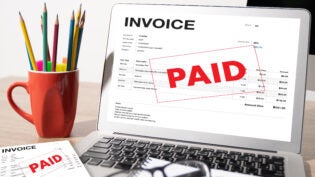
One of the challenges of working in the B2B space is that most commercial clients don’t pay their invoices as soon as you deliver your product or service. Instead, companies ask for 30- to 60-day payment terms.
Most large companies request terms for a simple reason: it’s good for their cash flow. They get to use your products and services for a month or two before they have to pay for them. Large companies are aware of their negotiating power, and they leverage it to their advantage. You either give them payment terms or they take their business elsewhere.
This situation affects many entrepreneurs, who seldom account for slow payments when they launch companies, and it eventually hinders growth because sales are limited by the amount of term credit that can be extended to clients. And, ultimately, the credit you can extend is limited by your capital, or lack thereof.
If you handle credit incorrectly, you may run out of money while you wait for clients to pay. Obviously, this scenario can lead to serious problems that could force you to delay—or miss—employee or vendor payments. It’s easy for cash flow problems to spiral out of control to the point where they threaten your business.
Providing term payments to clients isn’t inherently bad. You just have to know how to offer credit strategically—to grow your business. It’s a matter of following the correct steps and using common sense.
Step #1: Give credit selectively
Most small businesses mistakenly give payment terms to any large client who asks for them for one simple reason: they want the business. However, they never evaluate if they can actually afford to give credit in the first place.
Look at your cash flow and determine if you are in a position to offer credit. If you are not, consider alternatives. Step #4 discusses how to enhance the amount of credit you can give.
Also, offer credit strategically. Provide it only to creditworthy customers who could potentially become long-term, profitable clients. Remember that credit can easily turn into unpaid invoices and bad debt if you are careless. The next step examines how to evaluate credit.
Step #2: Evaluate the creditworthiness of all requests
Evaluate if a client deserves credit by reviewing a credit report purchased from a company such as Dun & Bradstreet or Experian Commercial. These reports summarize client payment habits—letting you know if they have a good track record and if their outlook is positive—and also provide a suggested credit line.
If the report is positive and the client deserves credit, consider providing them with payment terms. Always be careful, since you don’t want to overextend yourself. Do not offer credit if the client has either no track record or—even worse—a bad track record.
Step #3: Provide incentives for quick payment
You can be certain that if you give a client net-30 day payment terms, they will pay in 35 to 40 days. After all, an invitation to pay slowly is essentially an incentive to pay late. However, you can improve your cash flow by providing good clients with an incentive to pay sooner.
One common strategy is to offer clients a 2% discount if they pay invoices within 10 days. If your profit margin can afford it, this discount creates a potential win-win scenario. Your client gets to pay less –increasing their profitability—and your company gets paid sooner, allowing you to reinvest the money into your business.
This technique has one limit: the amount of credit you can offer is limited by your capital. However, you can increase the amount of credit you can offer—sometimes dramatically—by financing your creditworthy invoices using factoring, as described in the next step.
Read more on how to factor your invoices
Step #4: Finance your invoices to leverage growth
Sooner or later, your business will reach the point where you are offering as much credit as you can. You keep a cash reserve for temporary expenses, but, for the most part, you are waiting for clients to pay. You are “maxed-out.” Now, suppose a client places a large order. What do you do? You can’t afford to service it because you are essentially out of money. And you can’t afford to decline the order because the client will go to a competitor. In this case, the solution is to factor your invoices.
A factoring transaction allows you to finance your net-30 to net-60 invoices from creditworthy commercial clients. Instead of waiting up to two months to get paid, you can get financing immediately and use these funds to service your new contracts, pay expenses, and book new business. Factoring allows you to offer term credit effectively to your clients because you can always finance an invoice if you need funds.
This 4-step strategy, if used correctly, can help you grow your business by leveraging your biggest asset—invoices from creditworthy commercial clients.
 Author: Marco Terry is the managing director of Commercial Capital LLC, an invoice factoring financing company. He also blogs regularly at Factor-This! He can be reached at (877) 300 3258.
Author: Marco Terry is the managing director of Commercial Capital LLC, an invoice factoring financing company. He also blogs regularly at Factor-This! He can be reached at (877) 300 3258.5094 Views











